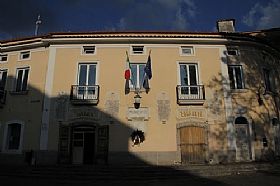Avellino

The city of Avellino, east of Naples, retains some remarkable structures and sights despite its unfortunate recent history. The city was heavily bombed in WWII, during which 1 in 8 citizens were tragically killed. It was rebuilt, only to be impacted by a destructive earthquake in 1980 that affected the entire central-eastern area of Campania and into next-door Basilicata. Despite these set-backs, Avellino and its population of 54,000 continues on as an industrial center and an interesting city.
The history of Avellino has its origins in the ancient Roman Abellinum. It was established near Atripalda, just four kilometers away, an Irpini town conquered by Rome during the Samnite wars in 82 BC, and became an important Roman crossroads town.
The present city was founded by the Lombards, and grew with more modern development in the 17th century, extending its territory westward towards Naples, and eastward, almost adjoining Atripalda.
After the Lombard domination, Avellino was under the rule of the Byzantines, Normans, Swabians, Angevin, Aragonese, the Viceroy of Spain, the Austrians and the Bourbons - the usual crowd of dominating rules that took over southern Italy. Capital of the province since 1799, Avellino actively participated in the brigand riots of 1820.
Because of the circumstances in the last century, the city has few important historical monuments. Among those standing, the Cathedral, dedicated to the Madonna dell 'Assunta, was built in the 12th century and rebuilt several times after, with a neoclassical facade redone in 1891, with frescoes and a wooden choir of the 16thcentury, inside. The church and its museum are definitely worth a visit.
Also remarkable is the 17th century fountain of Constantinople as well as the one dedicated to St Anthony Abbot, both Baroque, along with the 18th-century building in Piazza Caracciolo of Liberty, recently renovated and used as the Palace of the Provincial Administration.
Quite important is the provincial library that owns more than 150 thousand volumes. Close to the central Corso Vittorio Emanuele, stands the rebuilt De Peruta Palace, which has been the town hall for over a century.
There are a few ruins remains of the medieval castle, but more interesting is the Casina del Principe, a Caracciolo palace from the 1500s that has been restored and used for events. An interesting testimony of the past is also the Bourbon Prison, located in the centre of Avellino, just a few meters from the Court. Today it houses the Pinacoteca Provinciale art museum. The city of Avellino has also its Municipal Theater, the Carlo Gesualdo.
There is a fascinating sight nearby in the pretty town of Mercogliano. Here you'll find the funicular that takes you up to the Sanctuary of Montevergine on top of the mountain. There, the Benedictine abbey has been a true sanctuary, giving shelter to Jews in hiding during WWII, and where many townspeople from Avellino fled for safety during the Allied bombings of their city. It is a beautiful spot with breathtaking views and an intriguing history, and well worth the trip.
Avellino's patron saint is St Modestino.
Explore handpicked holiday lettings in Campania.

 Amalfi Coast
Amalfi Coast Sorrento Coast
Sorrento Coast Tuscany
Tuscany Cilento National Park
Cilento National Park Lake Como
Lake Como Rome and Latium
Rome and Latium Umbria
Umbria Capri and Ischia
Capri and Ischia Venice
Venice Puglia (Apulia)
Puglia (Apulia) Liguria
Liguria Sicily
Sicily Lake Maggiore
Lake Maggiore Lombardy
Lombardy Sardinia
Sardinia Lake Garda
Lake Garda Abruzzo and Marche
Abruzzo and Marche Calabria
Calabria

